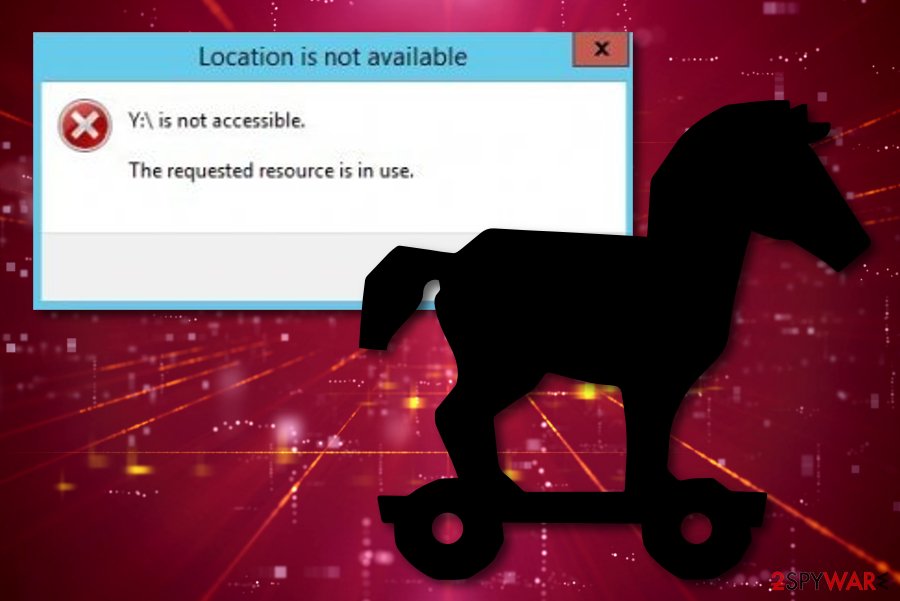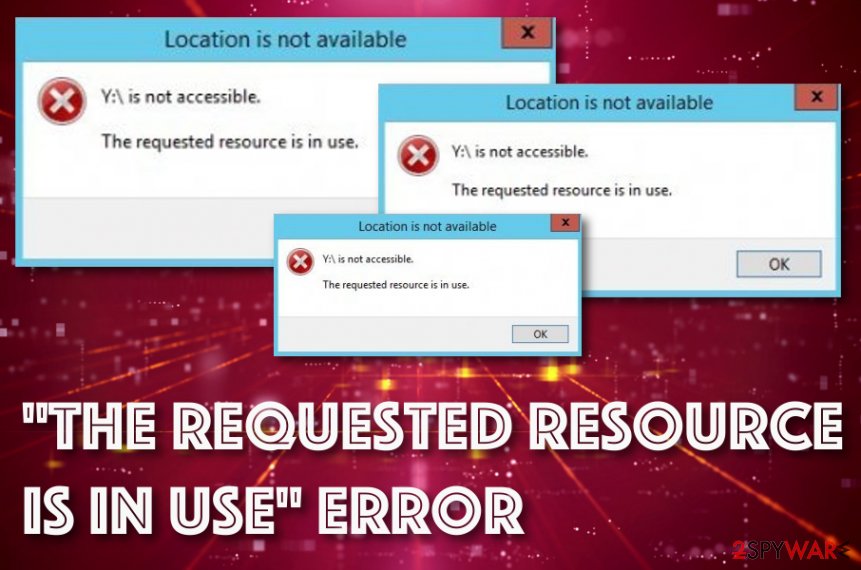“The Requested Resource is in Use” error – a dangerous Trojan virus that is capable of evading antivirus detection


“The Requested Resource is in Use” error is a sign of a trojan/rootkit infection that has somehow installed on your Windows computer. The name of this computer problem is just a disguise for the malware when it truly is called SmartService. Users have reported that this particular parasite is very difficult to deal with as it is capable of bypassing many antimalware programs.[1] The aim of “The Requested Resource is in Use” error trojan is to root deeply into the operating system, execute malicious payload and start performing damaging activities such as installing other dangerous software, stealing personal information, occupying web browser apps, infiltrating potentially unwanted programs such as browser hijackers, adware, and other variants.
SmartService trojan disables the antimalware software that is running on the infected Windows system to evade getting detected and let some other cyber threats to occupy the device. Nevertheless, the malicious software shows barely any symptoms of its appearance so it can be very hard to spot unless the user receives the “The Requested Resource is in Use” error message on his computer screen.
| Name | “The Requested Resource is in Use” error |
|---|---|
| Also known as | SmartService |
| Type | Trojan virus/rootkit |
| Target | This malicious piece of software targets computers that are using the Windows operating system |
| Activities | The trojan aims to root deeply into the OS, disable the antivirus software, install other malware and PUPs into the system, damage various products, occupy web browser apps |
| Spreading | Malware such as SmartService virus gets installed into the targeted computer system through software cracks, email spam messages and their malicious attachments, infectious hyperlinks and advertisements, etc. |
| Elimination | If you have encountered this malware on your Windows computer system, you should get rid of it as soon as possible with the help of automatical removal software |
| Fix software | If you have discovered any system damage on your machine, you can try repairing the compromised areas with the help of a tool such as Reimage Reimage Cleaner |
“The Requested Resource is in Use” error virus is capable of making unwanted changes to the Windows Registry such as including malicious registry keys that can bring big damage to your Windows computer system. Also, you might discover questionable processes operating in the Task Manager section that have been installed by the trojan and find unnoticed applications recently installed in the Programs location.
Even though “The Requested Resource is in Use” error is a dangerous malware form that can drop malicious content all over the computer system, before you see it, there will be almost no signs of the infection that would be accurate for a regular computer user and even some advanced ones. Another symptom of a trojan infection can be the CPU[2] energy level rising suddenly and exceeding the amount of 60% of the power.

“The Requested Resource is in Use” error is triggered by the dangerous Trojan horse called SmartService.

“The Requested Resource is in Use” error is triggered by the dangerous Trojan horse called SmartService.
However, SmartService virus is programmed not to eliminate executables such as cpx.exe, svcvmx.exe, splsrv.exe, szpsrv.exe, dataup.exe, qdcomsvc.exe, vmxclient.exe, and ct.exe from the computer system as they might be useful for its functionality. When you receive “The Requested Resource is in Use” error message, you will also be provided with the name of the file that is failing, e.g. egui.exe, zam.exe, mbam.exe, mcshield.exe, and a2start.exe.
You might not even think about something dangerous or suspicious when you receive the error message. However, it is definitely a sign that SmartService has occupied your Windows computer and the longer you keep this parasite on your system, the worse the consequences might be. First of all, it might give the criminals remote access to the computer so that they could complete whatever types of actions that they want.
Moreover, you can recognize that after “The Requested Resource is in Use” error appearance, some unknown software has landed on your computer. This trojan can open backdoors for other malware such as ransomware that locks up all files found on the system and demands a ransom for its recovery or some type of spyware that records personal information which is provided on the infected computer and tracks the user’s activities.
Furthermore, the trojan infection can lead to the installation of multiple potentially unwanted programs such as browser hijackers that are capable of altering your web browser settings such as the default search provider, homepage, new tab URL, displaying an entire load of ads, and redirecting the user to affiliate sources. SmartService itself might also occupy browser apps, provide malicious advertisements, and forcibly land the user on infected locations.

“The Requested Resource is in Use” error – a trojan infection that can steal all the personal and banking information that is provided on the Windows PC.

“The Requested Resource is in Use” error – a trojan infection that can steal all the personal and banking information that is provided on the Windows PC.
“The Requested Resource is in Use” error can also steal all the information that is stored on your computer system, including private details revealing your identity, banking data that allows connecting to your online bank account, browsing data that might bring income when shared with third-parties. Also, the malware can wipe out money from your bank account, put up private data for sale on the dark web or use it for identity theft.
Proper “The Requested Resource is in Use” error removal should help you prevent these types of activities and the sooner you eliminate the malware, the better it will be for the computer system. However, due to the fact that the Trojan virus[3] will likely be blocking your antivirus software, you should reboot your Windows machine in Safe Mode with Networking or activate System Restore to diminish all suspicious and malicious changes.
Afterward, you can remove “The Requested Resource is in Use” error from the infected Windows computer system properly. You should not try to get rid of the cyber threat by yourself as you might leave some steps skipped or accidentally miss some crucial content that will revive the malware later. Use reliable antimalware software to eliminate the trojan properly and also try employing software such as Reimage Reimage Cleaner for fixing damaged areas on your device.
Trojans arrive from places such as software cracks, infected files, and malicious links/ads
The most common way how a trojan can get inside the system is bogus software downloads. It might come along with various free programs, cracks that you download from torrents, file-sharing websites, and other online sources. Thus, it’s important to choose reliable places for software installation if you want to avoid dangerous malware infections. What is more, paying attention to the installation also helps to avoid potentially unwanted [4]programs or malicious applications.
According to cybersecurity researchers from NoVirus.uk,[5] trojan infections can also get downloaded through malicious executables, word documents or other files that come clipped to spam email messages. Be aware of email letters that you have not been waiting for but managed to slip in your inbox or spam section. Always check the sender, search for grammar mistakes in the received content, and do not open any clipped files before completing an antimalware scan first.
Furthermore, Trojan viruses are sneaky parasites that can come from various sources on the Internet, not only software cracks[6] or malicious email messages. If you have been infected with such virus, this might be because you could have clicked on an infectious hyperlink or ad while browsing the web. Thus, always make sure that you have updated your antivirus protection tool as it should inform you if something malicious is waiting ahead on a particular website.
Removal of “The Requested Resource is in Use” error trojan
“The Requested Resource is in Use” error removal should be performed along with the Trojan horse that is responsible for it. We want to remind you that trojans are hazardous cyber threats that might cause various computer-related problems or try to steal personal information. As you already know SmartService trojan protects potentially unwanted programs; thus, it might also install other unwanted or even malicious apps. Regarding this fact, it must be removed immediately.
Nevertheless, it might be hard to remove “The Requested Resource is in Use” error manually; you need to give reliable antivirus software a try. Try rebooting your computer via Safe Mode with Networking or activating the System Restore option to disable the malware and deactivate malicious changes on your Windows computer system. This type of activity might be extremely helpful if the Trojan virus has been blocking your antimalware products and evading detection.
Then, you might be able to install and use reputable security tools for the virus removal process. When you get rid of SmartService virus, you should search your computer system for possible damage by employing software such as SpyHunter 5Combo Cleaner or Malwarebytes. Furthermore, if these products find out some altered areas on your device, you might have a chance of repairing them with another program such as Reimage Reimage Cleaner .
This entry was posted on 2020-02-26 at 06:10 and is filed under Trojans, Viruses.

